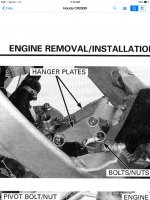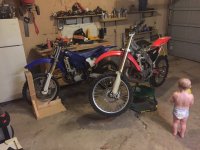stators can have a wire break and it will intermittently make contact and loose contact in the heating cycle from the motor running, very common...what you really need to do is hook up with someone with the same bike and do some parts swap to ID the bad part...or just break down and spend the $$$ to replace the probable parts
You are using an out of date browser. It may not display this or other websites correctly.
You should upgrade or use an alternative browser.
You should upgrade or use an alternative browser.
2 Stroke 2003 CR 250 Electrical Issues ( No Spark ) I need some input
- Thread starter CampinCracker
- Start date
stators can have a wire break and it will intermittently make contact and loose contact in the heating cycle from the motor running, very common...what you really need to do is hook up with someone with the same bike and do some parts swap to ID the bad part...or just break down and spend the $$$ to replace the probable parts
Thanks Mike, I am looking for that person now lol!
Pull your coil off the bike. Sand and clean the mounts of the coil and the frame. Then retry your ohms test of the coil. Also make sure your engine head stay is clean of rust and dirt. The head stay is important to create the good ground for the ignition system.
Paw Paw
Thanks Paw Paw, I was hoping you would chime in too. It seems a lot of the electrical posts I read you had some input. I will also be pulling the coil off of my other bike today to test it on the cr if that is possible. I will also be checking the peak voltage coming out of the exciter coil which Someone suggested yesterday. Thanks for all of the help guys!
Excuse my ignorance but whereas what is the engine head stay, I couldn't find anything in the manual that the coil plugs into on the head?Pull your coil off the bike. Sand and clean the mounts of the coil and the frame. Then retry your ohms test of the coil. Also make sure your engine head stay is clean of rust and dirt. The head stay is important to create the good ground for the ignition system.
Paw Paw
Ok, the coil is mounted on the frame. The electrical input to the coil comes from the stator to the coil. The coil grounds to the frame and back to the stator. The stator grounds to the engine. If the engine is not making good electrical contact through the frame or head stay, then you don't have a good ground on the electrical system and thus can have either a weak spark or no spark. The best way to insure this good ground is complete is for the engines head stay to be clean as it mounts to the engine and the frame. This is the same issue found with a lot of electrical issues in auto's when the ground straps to and from the body and engine are not clean and free from rust.
Remember you have to have a power source and a ground on any electrical system for it to function.
The engine head stay is the bracket that bolts to the head from the frame. It stabilizes the engine, but also is the major ground connection between the power source ( stator) and the coil and the ground.
FYI: I am not a big fan of auto adjusting multi meters for testing motorcycle electrical as the readings given don't always use the needed range to the testing so the results can be checked against the service manual.
Paw Paw
Remember you have to have a power source and a ground on any electrical system for it to function.
The engine head stay is the bracket that bolts to the head from the frame. It stabilizes the engine, but also is the major ground connection between the power source ( stator) and the coil and the ground.
FYI: I am not a big fan of auto adjusting multi meters for testing motorcycle electrical as the readings given don't always use the needed range to the testing so the results can be checked against the service manual.
Paw Paw
Last edited:
Thanks so much for the info, I will be checking this in the next hour so. Thanks again for all of the help on here, I will post any updates this afternoon.Ok, the coil is mounted on the frame. The electrical input to the coil comes from the stator to the coil. The coil grounds to the frame and back to the stator. The stator grounds to the engine. If the engine is not making good electrical contact through the frame or head stay, then you don't have a good ground on the electrical system and thus can have either a weak spark or no spark. The best way to insure this good ground is complete is for the engines head stay to be clean as it mounts to the engine and the frame. This is the same issue found with a lot of electrical issues in auto's when the ground straps to and from the body and engine are not clean and free from rust.
Remember you have to have a power source and a ground on any electrical system for it to function.
The engine head stay is the bracket that bolts to the head from the frame. It stabilizes the engine, but also is the major ground connection between the power source ( stator) and the coil and the ground.
Paw Paw
The exciter coil is generating 11volts,
the head stay and coil grounds are clean and no issues there, I also have a regular multimeter that I have been using as well. I did test the voltage coming from the Stator and it was 10.3V. I'm not sure what it should be. Also I tired to put the coil off of the YZ on the CR but it will not fit. However the coil from the YZ tested roughly the same as the one on the CR.Ok, the coil is mounted on the frame. The electrical input to the coil comes from the stator to the coil. The coil grounds to the frame and back to the stator. The stator grounds to the engine. If the engine is not making good electrical contact through the frame or head stay, then you don't have a good ground on the electrical system and thus can have either a weak spark or no spark. The best way to insure this good ground is complete is for the engines head stay to be clean as it mounts to the engine and the frame. This is the same issue found with a lot of electrical issues in auto's when the ground straps to and from the body and engine are not clean and free from rust.
Remember you have to have a power source and a ground on any electrical system for it to function.
The engine head stay is the bracket that bolts to the head from the frame. It stabilizes the engine, but also is the major ground connection between the power source ( stator) and the coil and the ground.
FYI: I am not a big fan of auto adjusting multi meters for testing motorcycle electrical as the readings given don't always use the needed range to the testing so the results can be checked against the service manual.
Paw Paw
Does anyone happen to know ow many volts should be coming from the yellow and white wire right out of the stator?
Thanks so much for the info, I will be checking this in the next hour so. Thanks again for all of the help on here, I will post any updates this afternoon.
The head stay is usually less prone to having corrosion mess with the contact than the pivot bolt and the lower engine mounts.
I dont have a manual for that year, and none of my honda manuals show voltage, but i could look again. The only manual i recall showing voltage readings is for my crf and those are peak voltage readings where a meter specifically for testing peak voltage is required.
The head stay is usually less prone to having corrosion mess with the contact than the pivot bolt and the lower engine mounts.
I dont have a manual for that year, and none of my honda manuals show voltage, but i could look again. The only manual i recall showing voltage readings is for my crf and those are peak voltage readings where a meter specifically for testing peak voltage is required.
I do have a meter for testing peak voltage readings. Thanks for the advice, I will check the lower engine mounts as well.
My son was about 4 when he started picking up wrenches and taking things off for me. I never pushed him to do it. Great way to spend time though.
One or maybe you can call it two things that ring a bell with me on that one. There is a motor that operates the ex/power valves. I think my next move might be to disconnect it as I do components on a street bike when spark goes weak (or a charging problem crops up). the other is that there is a rectifier and I believe it is also the voltage regulator separate from the cdi. more places to look.
One or maybe you can call it two things that ring a bell with me on that one. There is a motor that operates the ex/power valves. I think my next move might be to disconnect it as I do components on a street bike when spark goes weak (or a charging problem crops up). the other is that there is a rectifier and I believe it is also the voltage regulator separate from the cdi. more places to look.
Last edited:


